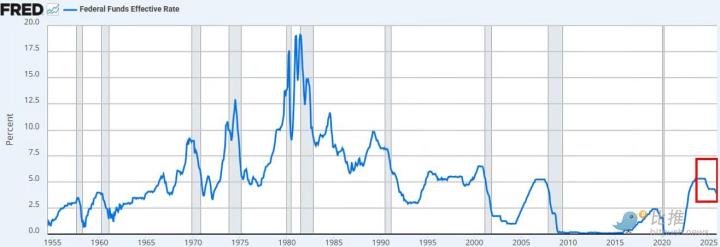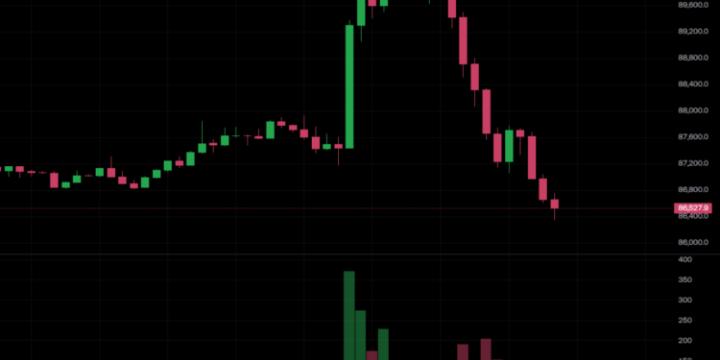
Written by: CoinGecko
Compiled by: Mars Finance, Daisy
introduce

The U.S. Federal Reserve's key interest rate decisions have a wide-ranging impact on global markets, including cryptocurrencies such as Bitcoin. The cryptocurrency market is often seen as a hedge against traditional assets and reacts dynamically to rate hikes and cuts. When the Fed adjusts its monetary policy, it triggers a chain reaction in the demand, volatility, and liquidity of cryptocurrencies, and investors need to pay close attention to these changes.
How interest rates affect cryptocurrencies
The impact of interest rate hikes and rate cuts on the cryptocurrency market varies, depending on investor sentiment and the broader economic environment. Rate cuts tend to generate optimism because they increase market liquidity, prompting more risky investments and boosting demand for speculative assets like Bitcoin. Conversely, rate hikes typically reduce market liquidity, making riskier assets less attractive. Next, let's take a closer look at these two scenarios - rate hikes and rate cuts, and their different impacts on the cryptocurrency market.
What happens during a rate cut?

Bitcoin Price Rise After 2020 Rate CutsA central bank or Federal Reserve rate cut decision is often a sign of economic weakness. When the Fed cuts rates, borrowing costs become lower, which tends to encourage riskier investments, including cryptocurrencies. Historical data shows that when the Fed cut rates by 0.25% in 2020, Bitcoin initially experienced a 60% correction, followed by a staggering 1,600% gain that year. Lower interest rates tend to shift investors from traditional savings vehicles to more speculative assets, such as cryptocurrencies. Especially when inflation concerns coincide with falling interest rates, Bitcoin's appeal as a safe-haven asset increases significantly. A research report from S&P Global supports this view and highlights the significant correlation between Bitcoin price fluctuations and monetary policy adjustments. Indeed, periods of low interest rates are often accompanied by increases in Bitcoin prices, while rapid rate hikes lead to price declines, reflecting broader market trends.
Why do interest rate hikes cause cryptocurrencies to fall?

Bitcoin Price Drops After 2022 Rate Hike On the other hand, rate hikes have the opposite effect. As Cointelegraph points out, rate hikes squeeze liquidity in financial markets, making riskier assets like cryptocurrencies less attractive. Rate hikes increase the returns on low-risk fixed-income instruments, prompting investors to pull money out of more volatile assets like Bitcoin. Cryptocurrencies reacted to reduced liquidity similarly to other risky assets: cryptocurrencies fell when the Fed announced its intention to raise interest rates in November 2021, and then continued to move lower when the Fed raised rates sharply in 2022. In addition, the collapse of cryptocurrencies such as LUNA/UST and the collapse of exchanges such as FTX further weakened traders' confidence in these virtual assets. At the time, the price of Bitcoin fell by about 65%. Currently, the market is in a consolidation phase due to the uncertainty about the speed of rate cuts and the state of the US economy. The price of Bitcoin is fluctuating according to market expectations: when the market expects rate hikes, the price of Bitcoin falls; when the Fed stops raising rates, the market begins to digest the expectation of rate cuts, and the price of Bitcoin rises accordingly. Currently, the market is in a consolidation phase as the pace of rate cuts and the state of the U.S. economy are not fully clear. But as the Fed begins to ease monetary policy after a period of tightening, a rise in Bitcoin prices seems inevitable. However, in the short term, Bitcoin may still enter a correction phase. Therefore, when the market expects the economy to improve, risky asset classes such as stocks and cryptocurrencies are also expected to rise together, driven by positive investor sentiment and increased liquidity. However, when interest rate hikes are mainly due to the Fed tightening monetary policy to combat inflation, the cost of capital rises, making risky assets such as Bitcoin less attractive and their value will fall as interest rates continue to rise.
Other factors
U.S. Treasury Bonds
Cryptocurrencies are often promoted as a panacea for all problems, whether it’s inflation, low interest rates, lack of purchasing power or a depreciating dollar. It’s easy to believe these positives, and cryptocurrencies seem to grow independently of other assets.

It is interesting to observe the correlation between Bitcoin price and the spread between the 10-year US Treasury bond and the 2-year US Treasury bond yield curve. The difference between the assets leads to a corresponding adjustment in Bitcoin price. As we know, when the yield on short-term US bonds is higher than that on long-term bonds, this is called an inverted yield curve. In normal circumstances, the yield on long-term bonds is higher because investors are more focused on riskier assets in the short term, such as Bitcoin, 2-year bonds, stocks, etc. However, when the yield curve is inverted, that is, short-term bond yields are higher than long-term bonds, it indicates that investors are uneasy about the economic conditions and may exit risky assets, including Bitcoin. Conversely, long-term bond yields higher than short-term bond yields (which we are seeing now) sends a positive signal for risk instruments such as cryptocurrencies.

A closer look at the differences between U.S. Treasuries and Bitcoin shows that Bitcoin’s range also lags behind the yield curve spread (divergence). Further synchronization of these assets, coupled with lower inflation and corresponding lower interest rates, could bring hope for Bitcoin’s medium- to long-term growth.
Institutional investors buying Bitcoin
Institutional investor interest in Bitcoin has surged, with hedge funds and asset managers viewing it as a hedge against fiat currency depreciation and an important diversification tool. The growing demand for Bitcoin ETFs highlights this trend as institutional investors seek regulated investment opportunities. According to Reuters , this institutional support is expected to support Bitcoin's price stability and future growth, driving a potential bull rally. The influx of institutional capital has been critical to Bitcoin's market growth, helping to maintain high price levels and provide long-term confidence in the asset's value. This shows that while Bitcoin does respond to changes in the federal funds rate, it does not do so in isolation. The impact of interest rates must be viewed in the context of broader market conditions, institutional interests, and regulatory changes.
Macroeconomic factors
China recently launched a massive stimulus package that includes lower interest rates and mortgage rates, freeing up liquidity, and pledging more than $100 billion to support the stock market. The sweeping move could have a major impact on global markets, boosting risky, liquidity-sensitive asset classes such as stocks, gold and Bitcoin. If successful, it could also push up inflation, which has been hovering just above zero, analysts say. The move, a departure from China's usual incremental approach, marks a major shift in its economic strategy, and its global ripple effects will be closely watched.
Bitcoin as a hedge against inflation
Bitcoin’s fixed supply of 21 million coins makes it a powerful hedge against inflation. Unlike fiat currencies, which governments can print, Bitcoin’s scarcity ensures that its value is not affected by inflationary pressures. This became evident in 2021, when U.S. inflation soared to 7% and Bitcoin appreciated by more than 300%, acting as a safeguard against currency debasement. Bitcoin shares characteristics with gold and is often referred to as “digital gold” because both appear to act as a store of value during periods of high inflation. Bitcoin’s decentralized nature ensures that it is not affected by government monetary policies, which often spark inflation.

Three waves of inflation in the 1970s Based on historical trends in the 1970s, inflation will develop in three waves, and experts believe that history may repeat itself. This may lead to further gains in Bitcoin, similar to the rise of gold during inflationary periods.

Inverse Correlation Between Bitcoin and the U.S. Dollar Index The inverse correlation between Bitcoin and the U.S. dollar is also crucial. When the U.S. dollar weakens, Bitcoin tends to strengthen, making it an attractive alternative. This inverse correlation is very similar to the inverse correlation between gold and the U.S. dollar, suggesting that Bitcoin may continue to serve as a hedge against fiat currency volatility. Although short-term cryptocurrency market volatility is affected by the Federal Reserve's interest rate policy, Bitcoin's medium- to long-term prospects are positive as it can offset inflation costs and maintain its value as a safe investment. This feature makes it attractive to those who want to maintain purchasing power during times of economic uncertainty. Medium-term impact on cryptocurrencies.

Based on the above fundamental analysis and focusing on the technical data on the chart, we can see the following: In the medium term, on the daily chart, Bitcoin has been fluctuating in a descending channel since March 2024. The current price faces important resistance at the golden Fibonacci zone, and a breakout above the upper border of the channel could send a bullish signal for the cryptocurrency market and a possible return to the all-time high (ATH) of 73,500. However, in the event of a correction scenario, the price could fall to the support level of 58,500, which is consistent with the 38.2% Fibonacci ratio.
Long-term impact on cryptocurrencies
In 2024, Standard Chartered analysts have repeatedly published predictions on the trend of the Bitcoin exchange rate. In April this year, they assumed that the price of BTC will grow to $150,000 by the end of the year. Experts from the brokerage firm Bernstein also believe that by the end of the fourth quarter, the quotes of the main cryptocurrency will break through the all-time highs of $80-90,000. In addition, Anthony Scaramucci, founder of the hedge fund SkyBridge Capital, said that by the end of the year, the price of Bitcoin could reach a record $100,000. This coincides with the forecasts of FBS analysts based on technical analysis of the weekly Bitcoin chart. The $100,000 level coincides with the 161.8 Fibonacci level at the breakout of the cup-handle pattern. However, a potential corrective trend could first reach the 50,000 area and then rise to a new ATH.
in conclusion
Changes in U.S. interest rates, especially rate cuts, tend to boost Bitcoin and the broader crypto market as lower rates encourage risky investments. Historical data shows that Bitcoin typically rebounds after rate cuts, driven by investor interest in speculative assets and concerns about inflation. While rate hikes would tighten liquidity and cause prices to fall, Bitcoin's long-term potential remains strong, with analysts expecting significant gains by the end of 2024. As a hedge against inflation and a speculative asset, Bitcoin's future depends largely on broader economic trends and the Fed's policies.








